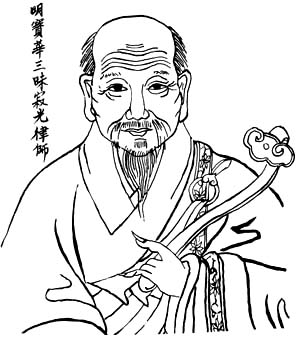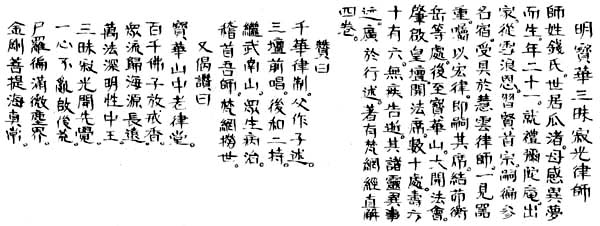|
Bodhi Seal of the Patriarchs MING DYNASTY VINAYA MASTER SAMADHI STILL LIGHT
--Composed
by the Venerable Master Hua The Master’s family name was Ch’ien and he lived in Kua Chu. His mother had a visionary dream just before the Master’s birth. When he was twenty-one years of age, the Master went to worship at Amitabha Temple. He then left the home-life under Dharma Master En of Hsueh Long Monastery. After studying the Hsien Shou School, he traveled widely visiting well-known places. Later he received the complete ordination from Vinaya Master Hui Yun who regarded him so highly that he entrusted the Master Samadhi Still Light with the propagation of the Vinaya and transmitted the abbotship to him. Commentary: A visionary dream: His mother dreamed that a High Master came to the house, and right after her dream the child was born. Because of the dream his family and friends nicknamed him "Shami," (Sramanera, or novice monk). The Hsien Shou School: We now at Gold Mountain study the Avatamsaka Sutra according to the Hsien Shou School. Afterwards, he traveled widely visiting well-known places: He studied for over ten years and then went everywhere to visit Masters of Great Virtue. Vinaya Master Hui Yun: Vinaya Master Hui Yun had received the precepts from Bodhisattva Manjusri. Manjusri had transmitted a robe to him, rubbed him on the crown, and said, "I have just transmitted the precepts to you." (See V.B.S. #45, P. 1.) If it was not from Manjusri that Vinaya Master Samadhi Still Light received the precepts. It was probably from Samantabhadra, because the two of them were old Dhyana colleagues. Who regarded him highly: When Vinaya Master Hui Yun first saw Master Samadhi Still Light, he knew that he could cultivate, that he was a Dharma Vessel, that he was a Dragon and Elephant at the Dharma's gate—an Old Patriarch. Entrusted him with the propagation of the Vinaya: Master Hui Yun said, "The Vinaya School is on the decline; you should promote it." And transmitted the abbot-ship to him: He transmitted the Dharma to him and made him the Abbot. Text: He built a hut at Heng Mountain in Nan Yao, and later built huts in other places as well. Later he went to Pao Hua Mountain, where he convened a large Dharma Assembly and established an Imperial Platform. Commentary: Heng Mountain in Nan Yao: Heng Mountain, in Hunan, is one of China's five sacred mountains. He built a hut: He built a small shack in the mountains and lived in it without having any false thinking whatsoever. Some say hut dwellers want to get away from it all and go live in the mountains, but to sit in a hut and strike up false thinking is useless. If you can live like a corpse then we can speak of living in a hut. This is not to say that you take so many drugs that you turn into a rock or a piece of wood, but that you have no false thinking and your heart is as firm as steel. If a tiger were to come to eat you, or a poisonous dragon were to strangle you, it would present no problem at all. If you can be like that, you may go live in the mountains. If you can't, you would only fight with yourself and receive no benefit. Imperial Platform: The Master conducted a precept ceremony and transmitted precepts to the Emperor. If you want to know which Emperor It was, look in the history books. In general, it wasn't you, and it wasn't me; so don't worry about it. Text: He transmitted the Dharma in several tens of places and, at the age of sixty-six, without on illness, he announced his departure, and died. The miraculous and remarkable events of his life have been widely circulated in writings. Be wrote A STRAIGHTFORWARD COMMENTARY ON THE BRAHMA NET SUTRA in four rolls. Commentary: He announced his departure and died. He was chatting with some disciples when all of a sudden he said, "Goodbye..." and left, died. How free he was! His life was filled with inconceivable, miraculous, and remarkable events, which were written up and widely circulated. Text: A verse in his praise says: A thousand flowers, the Vinaya rules: The son comments on the father's work. Formerly called to the three platforms, He later combined two kinds of maintaining. The successor of Nan Shan, He cured the illnesses of beings. We bow our heads to the Master, As the Brahma's Net saves the world. Commentary: A thousand flowers refers to the opening lines of the gatha in the BRAHMA NET SUTRA, "As, now, Nisyanda Buddha Sits upon the lotus dais, Revolving atop a thousand lotus flowers In each of which appears the Buddha Sakyamuni..." The son is Vinaya Master Samadhi Still Light, and the father is the Buddha. The two kinds of maintaining are "to maintain stopping," that is, to stop evil, and "to maintain action," that is, to do good deeds. Students of the Vinaya should know these. Nan Shan, Southern Mountain, refers to the great Vinaya Master Tao Hsuan. (See V.B.S. 4l, p. 1). The Brahma's Net refers to the Master's commentary on the Brahma Net Sutra. It saves the world like a net rescuing people from suffering and distress. Text: Another verse in his praise says, Upon Jeweled Flower Mountain, In the old precept hall, A hundred thousand sons of the Buddha Release the morality fragrance. All the streams flow to the sea From sources far away; The ten thousand dharmas, Self-Nature King Are deeply understood, The enlightenment of Samadhi Still Light Like that of those of old, As he single-mindedly biased a trail For future generations. The sila still pervades through, realms In number as motes of dust; True permanence is found within The Vajra Bodhi Sea. Commentary: The Monastery at Jeweled Flower Mountain is known to everyone as simply "The Old Precept Hall." There's a terrifying spot on the mountain called Yin Feng Cave. If you have offense karma you may die or encounter some mishap as you pass the cave to go to take the precepts. The saying goes, "If there is injustice, it is repaid; if there is enmity, it is returned." It's not easy to receive the precepts there since such demonic obstacles frequently occur. For example, there was a Bhiksu there who mismanaged the money. He was reborn as an ox and then returned to the monastery. Every year, spring and autumn, they conduct precept transmission ceremonies, thus creating a hundred thousand sons of the Buddha: Bhiksus, Bhiksunis, Upasakas, Upasikas, men Bodhisattvas, and women Bodhisattvas. They all release the morality fragrance because they hold the precepts and don't strike up false thinking. Not one of them pretends to be a serious cultivator while actually just day dreaming all day long. You can tell whether or not someone cultivates simply by his smell. If one does a lot of false thinking, his body will give off a bad odor which you can smell from ten to twenty feet, or even several miles away; you don't have to be right next to him. It's most inconceivable. All the streams flow to the sea: those who went to Jeweled Flower Mountain to seek the precepts were like streams flowing into the ocean. From sources far away: people came from all directions to seek the precepts there. Someone may ask, "Old Bodhisattva, where did you take the precepts?" and if you answer, "Jeweled Flower Mountain," he will respect you, because the precepts are well kept there. Those who have taken the precepts there emit a fragrance. In fact, on just hearing your name, people will be aware of the fragrance. If you deeply understand the ten thousand dharmas, you will also understand the king within your own nature. Master Samadhi Still Light worked with one heart to blaze a trail in order to save those of the future. Sila,
the precepts, pervades realms in number as motes of dust. Wherever the precepts are transmitted is just the
Vajra Bodhi Sea—true permanence, for the Buddhadharma thus remains in the world forever. And now,
he's jumped into our VAJRA BODHI SEA.
|

